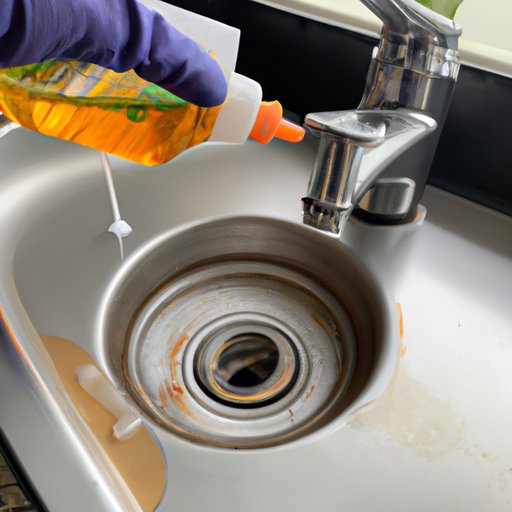
Introduction: Overview of the Problem
The kitchen sink is one of the most frequently used parts of the home, yet it’s often neglected when it comes to regular cleaning and maintenance. If not taken care of properly, kitchen sinks can quickly become clogged with food particles, grease, grime, and bacteria that can cause unpleasant odors and even health risks. Fortunately, with a few simple steps, you can easily keep your kitchen sink in tip-top shape.
Benefits of Regular Maintenance
Regularly maintaining your kitchen sink will help prevent clogs and keep it smelling fresh. It will also make it easier to clean, saving you time and energy. Additionally, regular maintenance can help extend the life of your sink, preventing costly repairs or replacements down the line.

Using Baking Soda and Vinegar to Unclog the Sink
If your sink is clogged, one of the easiest ways to unclog it is by using baking soda and vinegar. Here’s how to do it:
Step-by-Step Instructions
1. Pour 1/4 cup of baking soda down the drain.
2. Follow with 1/2 cup of white vinegar and cover the drain with a stopper or cloth.
3. Allow the mixture to sit for 15 minutes before rinsing with hot water.
4. Repeat if necessary.
Alternative Solutions
If the baking soda and vinegar method doesn’t work, there are several other solutions you can try. For example, you can use a plunger or a plumber’s snake to clear the clog. You can also try pouring boiling water down the drain or using a commercial drain cleaner. If none of these methods work, it’s time to call a professional plumber.

Scrub Away Grease and Grime with a Sponge and Hot Water
Once your sink is unclogged, it’s time to give it a good scrubbing. Here’s what you need to do:
Materials Needed
• Sponge
• Hot water
• Dish soap
• Cleaning cloth
Tips for Effective Cleaning
1. Start by wetting the sponge with hot water and adding a few drops of dish soap. Scrub the sink with the sponge, being sure to get into all the nooks and crannies.
2. Rinse the sponge frequently and use a clean cloth to dry the sink after each rinse.
3. If there is any remaining grime, create a paste using baking soda and water and use it to scrub away the residue. Rinse and dry thoroughly.

Clean Stainless Steel Sinks with a Soft Cloth and Specialized Cleaner
Stainless steel sinks are especially prone to fingerprints and smudges, which can be difficult to remove. To keep your stainless steel sink looking its best, it’s important to use the right cleaner and technique.
Choosing the Right Cleaner
When selecting a cleaner for your stainless steel sink, look for one specifically designed for stainless steel surfaces. These cleaners usually contain a combination of surfactants and polishes that help remove dirt and grime while leaving behind a protective coating.
How to Apply the Cleaner
1. Wet the sink with warm water and apply the cleaner according to the instructions on the package.
2. Use a soft cloth to rub the cleaner in small circles, paying special attention to any areas that are particularly dirty.
3. Rinse the sink thoroughly with warm water and dry with a clean cloth.
Sanitize the Sink with Disinfectant
To ensure your sink is completely free of bacteria and germs, it’s important to use a disinfectant after cleaning. Here’s what you need to know:
Different Types of Disinfectants
There are several different types of disinfectants available, including bleach, hydrogen peroxide, and alcohol-based products. Choose the one that best suits your needs and follow the instructions on the package.
Application Techniques
1. Spray the disinfectant onto the sink and let it sit for the amount of time recommended on the package.
2. Wipe the sink with a clean cloth to remove any excess disinfectant.
3. Rinse the sink thoroughly with warm water and dry with a clean cloth.
Keep Your Sink Clean with Regular Maintenance
To keep your sink looking and smelling its best, it’s important to practice regular maintenance. Here are a few tips to help you stay on top of it:
Scheduling Cleanings
Set aside time each week to give your sink a thorough cleaning. This will help you stay on top of any potential problems and keep your sink looking its best.
Additional Tips
• Try to avoid letting food particles and grease accumulate in the sink.
• Don’t pour cooking oil down the drain; instead, dispose of it in a sealed container.
• Use a strainer to catch food particles and other debris.
• Avoid using harsh chemicals or abrasive cleaners that could damage the surface of the sink.
Conclusion
Keeping your kitchen sink clean and in good condition requires regular maintenance. With the right cleaning supplies and techniques, you can easily keep your sink free of clogs and dirt, ensuring it stays in top shape for years to come.


